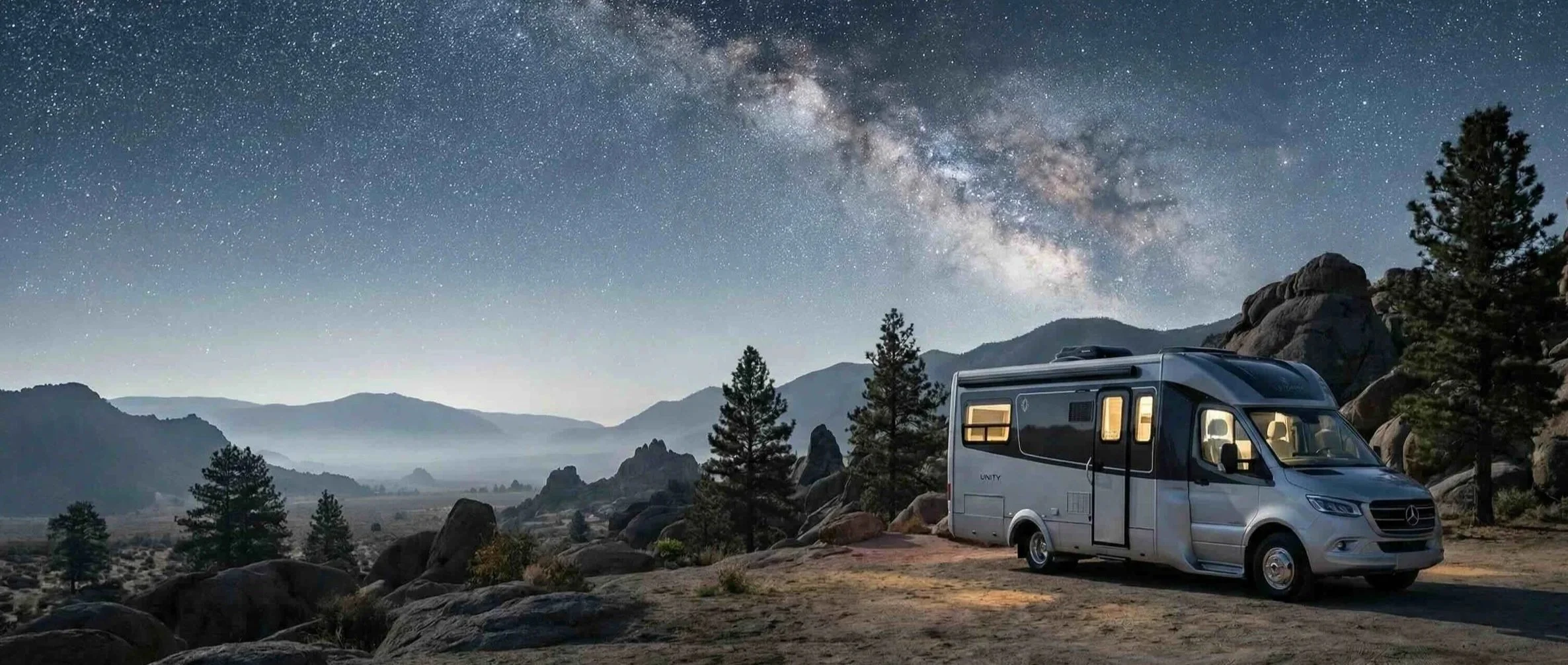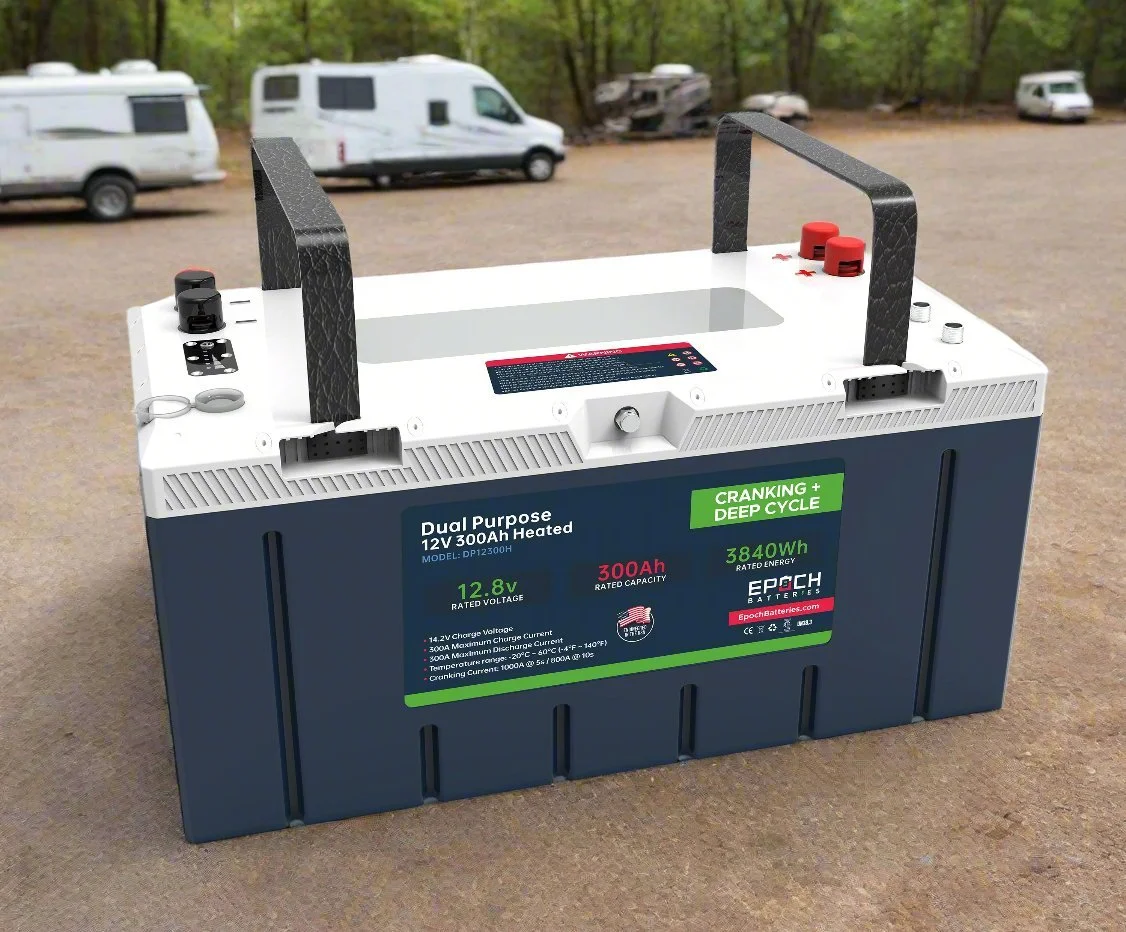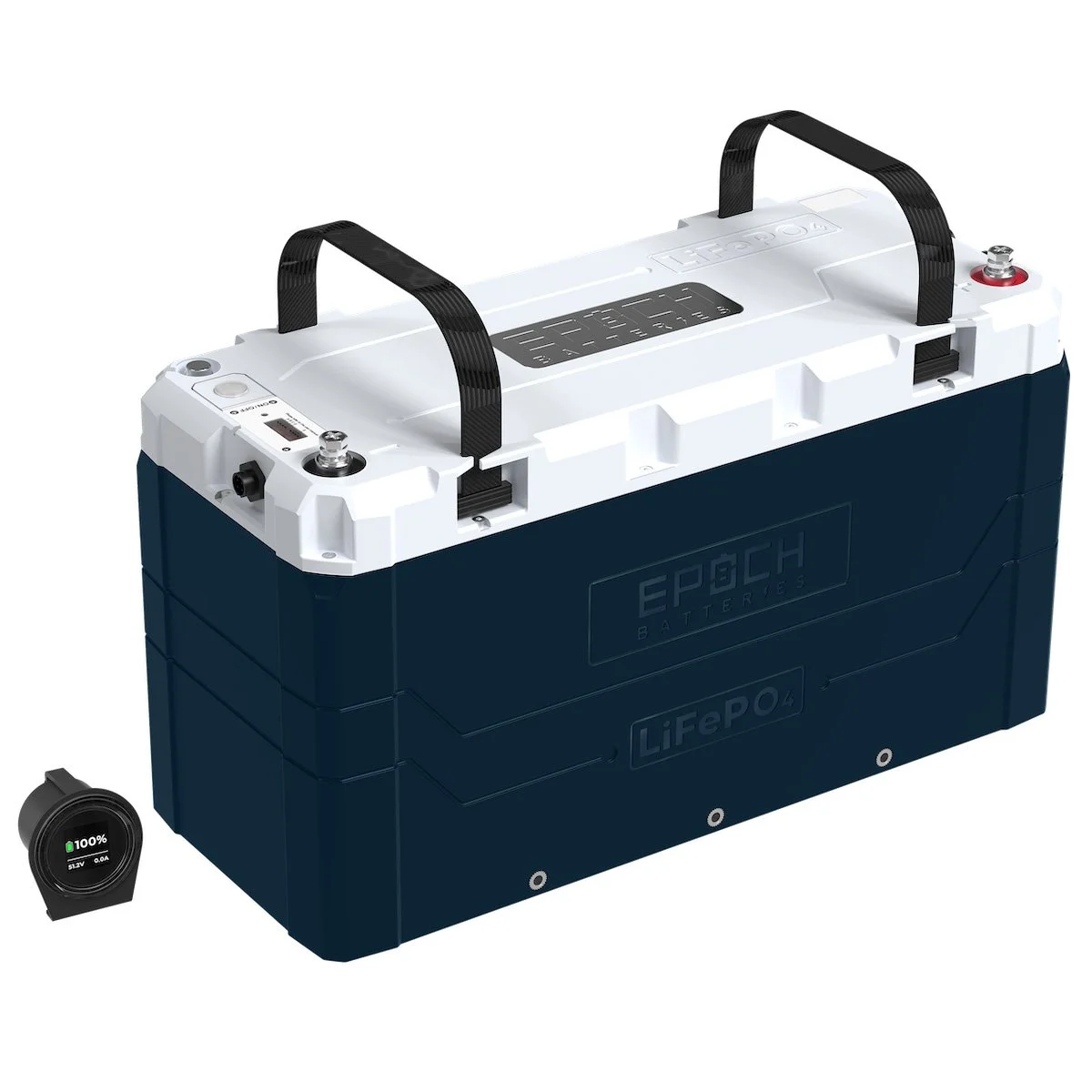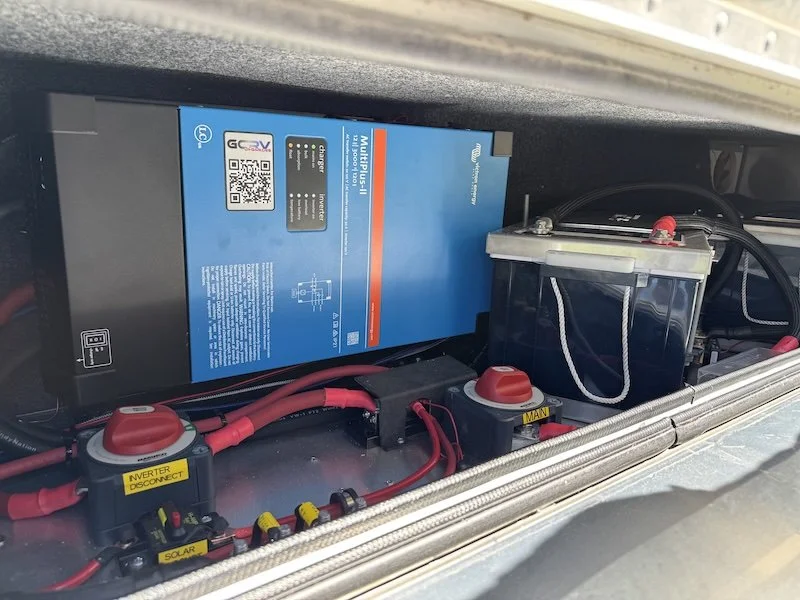
RV Lithium Upgrade Guide 2026 – Lithionics vs Epoch + Free Runtime Calculator
Estimate your runtime, analyze your energy needs, and get a precision-matched system recommendation for your RV.
How to Choose the Right Lithium Battery for Your RV
Upgrading our RVs to lithium batteries has completely transformed the way Janet and I travel.
In our Leisure Travel Van, we equipped it with a Lithionics 320Ah battery and a 3000W inverter, and our Airstream is now running on a massive 920Ah of Epoch power, have set us free from power pedestals and the constant worry of running out of energy.
With these upgrades, we enjoy hours of air-conditioning runtime, silent mornings with the coffee maker and true off-grid independence—no matter where the road takes us.
Today, Pagosa Supply Co is an authorized dealer for both Lithionics and EPOCH, offering expert system installs designed to elevate your RV experience. Explore this guide to understand what lithium power can do, how many amp-hours you need, and reach out anytime to chat about turning your RV into a true boondocking machine.
Explore How Upgrading Can Make Your RV Life Even Better
Optimize Your RV Power Setup with Interactive Lithium Battery Calculators — Use our free, interactive Lithium Charge Time and Runtime Calculators to estimate how long your connected equipment can run on a single charge and how long it takes to recharge your 12-volt lithium battery.
Simply enter your battery’s amp-hours, charge rate, or power load in watts, and adjust the state of charge or depth of discharge to see real-time results. Designed for RV owners, solar setups, and off-grid power systems, these tools help you choose the right size for your lithium battery upgrade, chargers, and inverters for maximum efficiency and reliability.
Ready for Off Grid Freedom?
Pagosa Supply Co offers Lithionics & Epoch Lithium Batteries plus expert installation. Get Your Quote Today.
Real-World RV Power Calculator: Solar, Lithium, and Daily Loads
No more hoping your batteries last “a few days.” These live calculators and real-world charts (built from thousands of actual boondocking rigs) instantly tell you:
- How long your lithium bank really lasts with your daily usage
- Exactly how many watt-hours your roof solar actually delivers (hint: it’s never “panel watts × 8”)
- What a normal boondocking day costs in power (most people use 1,300–1,600 Wh)
- How many nights you can truly stay out with (or without) solar
Default numbers are set to what 90 % of experienced boondockers see in the real world — just click any panel below and play with your own numbers. Everything updates instantly.
| Appliance | Avg Watts | Notes |
|---|---|---|
| LED Lights (each) | 5 – 20 W | |
| 12V Compressor Fridge | 60 – 120 W | ∼40 % duty cycle |
| Residential Fridge (inverter) | 150 – 400 W | |
| 13.5k Roof A/C | 1,300 – 1,700 W | ∼2,500 W startup |
| 15k Roof A/C | 1,500 – 2,000 W | ∼3,000 W startup |
| Microwave | 800 – 1,200 W | Short bursts |
| Coffee Maker | 900 – 1,500 W | |
| Induction Cooktop (1 burner) | 1,200 – 1,800 W | |
| CPAP Machine | 30 – 60 W | Humidifier ≈ doubles |
| Laptop Charging | 45 – 100 W | |
| LED TV 43–55″ | 60 – 120 W | |
| Inverter Idle Draw | 10 – 30 W | Turn off when not needed |
| Starllink Standard | 50 – 75 W | Turn off when not needed |
| Starlink Mini | 25 - 40 W | Turn off when not needed |
Most real boondockers use 1,300–1,600 Wh per day.
| Item | Hrs/Day | Draw | Daily Wh |
|---|---|---|---|
| LED Lights | 6 h | 30–50 W | 180–300 |
| 12V Fridge | 8–12 h eff. | 40–60 W | 400–700 |
| TV | 4 h | 60–80 W | 240–320 |
| Phones/Tablets | — | — | 40–100 |
| Furnace (winter) | 0–6 h | 60–100 W | 0–600 |
| Starlink Mini | 10 h | 25 - 40 W | 400 - 700 |
| Phantom + Inverter | 24 h | 15–50 W | 360–1200 |
RV Roof Solar Reality: — Even in ideal sun you’ll often get only ~3-5 full-sun-equivalent hours/day — under clouds or poor orientation it can drop much lower. Use this data for the solar section in the boondocking calculator below.
| Roof Panels | Conservative / Cloudy | Good Sunny Day | Year-Round Avg |
|---|---|---|---|
| 200 W | 400 – 600 Wh | 700 – 900 Wh | 550 Wh |
| 300 W | 650 – 900 Wh | 1,000 – 1,300 Wh | 800 Wh |
| 400 W | 900 – 1,200 Wh | 1,300 – 1,600 Wh | 1,100 Wh |
| 500–600 W | 1,200 – 1,700 Wh | 1,800 – 2,400 Wh | 1,500–1,800 Wh |
| 800 W | 1,800 – 2,300 Wh | 2,600 – 3,200 Wh | 2,200 Wh |
1,000 – 1,600 Wh per day into the batteries.
Can You Run an RV Air Conditioner on Lithium Batteries? Here’s What You Need to Know
Get even more info with this guide that breaks down exactly what you need, how long you can expect your A/C to run, the best batteries and inverters for the job, and how to avoid the most expensive mistakes we see in DIY installs.
Yes — completely possible and very common with the right upgrade.
A properly sized LiFePO₄ battery bank + 3000 W inverter + Soft-Start device = hours of quiet, reliable off-grid air conditioning. Pagosa Supply Co can turn your RV into the ultimate boondocking machine.
1. 3000 W pure-sine inverter with strong surge & proper cabling and fusing
2. 300–600+ Ah of quality lithium (
Epoch
or
Lithionics
)
3.
Soft Start / Easy Start
installed on the A/C (reduces startup amps 60-70 %)
Your RV air conditioner is designed to be powered from a 30 or 50 amp power source. This is because compressor motors are connected in a way that lets them draw as much power as required to get up to speed quickly.
Because of this design, compressor motors require a massive current surge when they start that is too much to handle for a 15 or 20 amp breaker or the RV’s inverter — but there is a solution.
Soft Starts / Easy Starts effectively limit the inrush current and improve the stability of the power supply while reducing transient voltage drops that may affect or damage other loads.
This eliminates the need for excessive power supply capacity, resulting in reduced equipment costs (charge meter, circuit breaker, and power wiring), and it extends the service life of the motor or compressor.
Keep in mind that temperatures and a multitude of factors +/- these times
• 300 Ah → 1.5 – 2.5 hours• 600 Ah → 3.5 – 5 hours
• 920–1200 Ah → 8 – 12+ hours
Add 600–800 W solar and enjoy even more on sunny days.
Upgrade A/C unit to Gree, Atmos or other high efficiancy units for best results
Lithionics → Best if you want to run a 3 kW inverter off one single battery. Unmatched BMS and discharge.
Epoch → 95 % of the performance, built-in heating, Bluetooth, and 30-40 % cheaper.
Many of our off-grid upgrade customers choose Epoch and love it for the value. The ones who pick Lithionics usually have dual A/Cs or simply want the absolute best.
We design & install complete lithium A/C systems that actually work — guaranteed.
Recommended Lithium Batteries for RVs and Off-Grid Power
If you’re ready to upgrade your setup, explore our premium LiFePO₄ lithium batteries.
We offer models designed for efficiency, durability, and high discharge rates perfect for mobile and stationary systems.
🔋 Lithionics 305Ah, 320Ah or 640Ah GTX Battery — Built like a tank, trusted, UL-listed power for luxury RVs
🔋 Epoch 300Ah or 460Ah— Bang for the buck, lightweight, reliable and rugged
Each battery includes an advanced Battery Management System (BMS), Bluetooth conectivity and self heating for safety, fast charging, and long cycle life.
Lithionics VS EPOCH for a 3000W Inverter
NOTE: 3000W inverters only needed if running high amp appliances like A/C units.
A 3 kW inverter (such as a Xantrex 3000 XC PRO or a Victron MultiPlus II 3000 imposes specific electrical-current and battery-management demands for safe, reliable operation. When selecting a battery-bank configuration to pair with such an inverter, the discharge current capability and BMS (battery-management system) limits must be considered.
All three Lithionics we offer allows single battery powering of a 3000W inverter, however only the EPOCH 300 Pro is able to accomplish this. Essentials 300, 460 and 460 Elite need dual battery setups to handle the amps required.
If money is no object, pick the Lithionics hands down. By far the Ferrari of Lithium batteries. However, a battery is just a storage device, and today, EPOCH makes a quality, robust battery for a fraction of the price of a Lithionics. So if you want great performance with great features, EPOCH is an easy choice.
Epoch Essentials, Pro & Elite Series Lithium
-

Epoch 300 Pro
With the 300 Pro Version, you can power a 3000W inverter with a single battery. Heated & Bluetooth equipped
-

Epoch 300ah Essentials
An amazing bang for your buck. 300ah in a compact package. (Need 2 for 3000W Inverters). Heated & Bluetooth equipped
-

Epoch 460ah Essentials
460ah at a price you can’t ignore. Great build quality and Heated & Bluetooth equipped
-

Epoch 460 Elite
IP67 Rated, 460ah and built like a tank. amazing Marine grade battery. Heated & Bluetooth equipped
Lithionics GTX 12V Series
-

Lithionics 302 Boss
305ah perfect for small battery boxes or compact spaces. Heated & Bluetooth equipped.
-

Lithionics GTX12V 320ah
The original workhorse! 320ah best of a battery. Self heated & Bluetooth Equipped.
-

Lithionics 630 - 12V GTX
630ah in one battery! All the features, built to take on any power need you throw at it.
Frequently Asked Questions About RV Lithium Batteries
Lithium batteries provide more usable energy, faster charging, dramatically lighter weight, and 3–5× longer lifespan.
A single 100 Ah lithium battery delivers nearly the same usable power as a 170–200 Ah lead-acid or AGM bank because you can safely use 90–100 % of its capacity (vs ~50 % with lead-acid).
300 Ah × 12.8 V = 3,840 Wh total → ~3,460 Wh usable at 90 % DoD.
At a typical 300 W average load → 11–12 hours of runtime.
At a light 150 W load → 22–23 hours.
Use the Runtime Calculator above for your exact setup.
Yes — solar is one of the best ways to charge lithium. Just make sure your charge controller is set to the proper LiFePO₄ profile (usually 14.4–14.6 V bulk/absorption).
MPPT controllers are strongly recommended for maximum efficiency.
Quality LiFePO₄ batteries can safely go to 100 % depth of discharge thousands of times. For maximum lifespan, most owners set low-voltage cutoff at 10–20 % remaining (80–90 % DoD).
Both are excellent premium brands — here’s how to decide:
- Choose Lithionics if you want the absolute best built-in BMS, Bluetooth monitoring, CAN-bus integration with Victron/Battle Born systems, and a 12-year warranty. They’re the gold standard for full-time RVers and overlanders who demand zero-fail performance.
- Choose Epoch if you want incredible value, built-in heating for cold-weather camping, equally robust BMS, and slightly lower price per Ah. Epoch is perfect for weekend warriors and boondockers who still want top-tier quality.
Both brands are drop-in replacements, UL-listed, and we stock and support both. Most customers end up choosing based on budget vs desired features — we’re happy to help you pick the perfect one.
Our lithium experts will design a complete power system — batteries, inverters, solar, chargers — custom-built for your exact RV, van, or cabin.
About Paogsa Supply Co
Pagosa Supply Co was co-created by passionate RV traveler and YouTube creator Brandon Hensley of Pagosa Adventures, known for real-world testing and education on RV power systems, off-grid travel, and lithium battery technology. After years of RV experience — first in a Leisure Travel Van powered by a Lithionics lithium system, and now in an Airstream Globetrotter equipped with Epoch batteries — our co-founder turned that expertise into a trusted resource for RV owners looking to modernize their energy setup.
At Pagosa Supply Co, we don’t just sell lithium batteries — we live the lifestyle they power. Every product we carry, from Lithionics to Epoch, is field-tested and chosen for safety, performance, and reliability. Our goal is to educate RVers on how lithium technology transforms travel freedom: longer run times, faster charging, and a true off-grid experience.
Whether you’re upgrading your first camper van or building a complete solar power system for your Sprinter or Transit Van, Airstream, Fifth Wheel or Class C RV, Pagosa Supply Co provides expert guidance, proven components, and honest advice backed by real-life experience.

